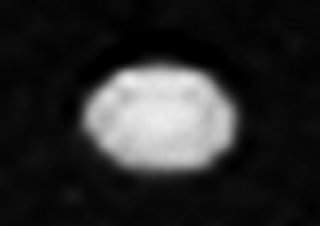On the moon is Neptune's Despina, a small moon with a diameter of about 150 km, which in the blurry photograph of the Voyager 2 spacecraft in 1989 appears to have an octagonal shape.

When Voyager 2 passed by Neptune in 1989, it photographed it, its rings, its moon Triton and several other moons. Some of them were discovered for the first time by the spacecraft itself and, like other moons in the solar system, they are asteroids for all intents and purposes. The length of some of the moons reaches hundreds of kilometers. The largest of them is Proteus, which is 420 km long and the smallest is Despina, which is 150 km long. The rest are tens of kilometers long or less. The number of photographs is small, and because of the greater distance from it the photographs are low resolution and blurry. You can see details but not in high resolutions. The most interesting of them is Despina.
Despina was first discovered by the Voyager spacecraft in July 1989. Its distance from Neptune is 52.5. km and circles it once in 0.33 Earth days, a little more than 8 hours. This means that Neptune's orbit is less than the time it takes for the planet to rotate around itself (16 hours). In this sense it resembles the lunar Phobos of Mars. Its density is 1.2 grams per cubic meter, a little more than water. It is likely that it is porous and that there is water in it. In terms of its location in the system of Neptune, its location is inside the Le Verner ring.
Voyager 2 Sdra Eretzeh only has one photograph of it, so any attempt to know what is on the other side is a guess. It is an unusual moon in its appearance among the photographed moons of Neptune. Although the photo is blurry, you can see that it looks like an octagon (8 sides). Is it really so? It may be that photographs from a shorter distance will be a little different. Inside the outline is a dark continuous line that also looks like an octagon. By zooming in, you can see that within this line there are light spaces. The black areas are possibly large craters on the order of tens of kilometers in size. Why they are arranged like that is not clear. It is possible that there are craters with a diameter of a few kilometers, but they are below the resolution of the photograph. The center of the photograph is also in the form of a very light octagon. There is a strong reflection of light here.
מקור
https://en.wikipedis.org/wiki/Despina_(Moon)

4 תגובות
This is a good and educational site
Why not? If you have a talent for writing, go for it. You have already given chapter heads. could be nice
Abby: A very bad idea. The book will be sold in one copy, at the Book Junction.
Low density - porous maybe hollow...
Maybe it's not "Despina", but "ship", that is, a spaceship of frozen aliens that were sent from a dying planet to inhabit the Earth, entered the solar system at a wrong angle and got into a state of rotation around Neptune...
Maybe it is hollow and contains the aliens in a frozen state inside...
Maybe the goal was to settle the earth a few million years ago, by mistake it lost the track, and since then it has been stuck in this situation...
Just an idea for a science fiction book...